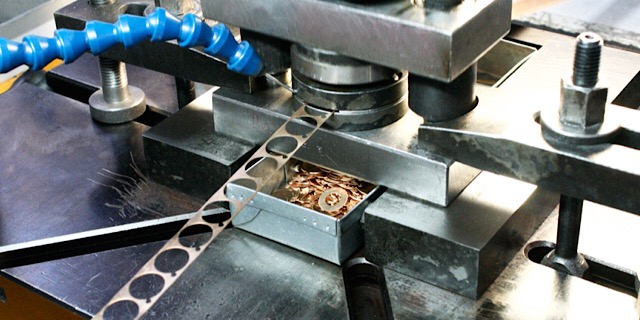Exploring the Duty of Metal Stamping in Modern Engineering Solutions
Exploring the Duty of Metal Stamping in Modern Engineering Solutions
Blog Article
Metal Marking Advancements: Elevating Manufacturing Processes for Superior Outcomes
In the world of making processes, metal marking has long been a foundation strategy for producing a variety of accuracy parts. With the ruthless march of technical innovation, the landscape of steel marking is going through a considerable improvement. Innovations in this area are not just enhancing the efficiency and top quality of manufacturing however are likewise paving the method for new opportunities that were formerly past reach. As the sector welcomes these cutting-edge advancements, a redefinition of what is possible in manufacturing is underway, promising remarkable results and establishing new criteria for quality in the field.
Development of Steel Stamping Strategies

In addition, developments in material science have actually caused the growth of high-strength alloys that can now be flawlessly marked into elaborate forms, dealing with a wider variety of commercial applications. The combination of robotics and synthetic knowledge has additionally enhanced the stamping procedure by enhancing speed and accuracy while decreasing the risk of human error.

Impact of Advanced Materials
Have advanced products changed steel marking processes significantly in the manufacturing industry? By making use of materials such as high-strength alloys, advanced composites, and cutting-edge finishes, steel stamping processes can now generate parts that are lighter, more powerful, and more resilient than ever previously.
These sophisticated materials supply superior mechanical homes, rust resistance, and thermal security, allowing makers to satisfy the demands of modern-day industries such as aerospace, automotive, and electronic devices. Additionally, making use of sophisticated products in metal marking has actually facilitated the production of complex geometries and detailed styles that were previously unattainable through conventional approaches.
Additionally, the application of sophisticated products has caused lowered product waste, lower manufacturing expenses, and shorter preparations, making steel stamping processes extra lasting and cost-effective. As modern technology remains to advance, the impact of advanced materials on metal marking procedures is anticipated to drive more development and boost the competition of makers in the worldwide market.
Automation in Steel Stamping
The development of metal marking processes driven by the integration of advanced materials has actually set the phase for significant developments in automation within the manufacturing industry. Automation in metal marking has changed manufacturing processes, improving performance, precision, and general output high quality. Via the application of robotics, sensing units, and computer-controlled systems, tasks that were once manual and time-consuming can now be performed with unmatched rate and precision.
Automation in steel stamping not only increases manufacturing prices yet likewise guarantees uniformity in the manufacturing process. By minimizing human intervention, the threat of mistakes is significantly minimized, leading to higher degrees of item harmony and integrity. In addition, automation allows producers to embark on complex marking jobs that would be challenging or unwise to accomplish manually.
Furthermore, automation in metal stamping adds to a more secure working atmosphere by decreasing the demand for staff members to involve in repetitive or dangerous jobs - Metal Stamping. This shift in the direction of automation not only boosts efficiency yet additionally leads the means for the future of production, where technology plays a main function in driving functional excellence
Quality Assurance and Assessment Systems
With a concentrate on accuracy and dependability, top quality control and inspection systems play an important function in making certain product excellence in steel stamping processes. These systems are created to keep track of every phase of manufacturing, from material assessment to the end product, to assure that all components meet the required standards. By implementing sophisticated modern technologies such as optical evaluation systems, coordinate gauging makers (CMM), and automated evaluating devices, makers can discover also the smallest inconsistencies in dimensions, surface top quality, and total integrity of stamped parts.

Sustainability Practices in Metal Stamping
Building upon the foundation of accuracy and reliability established via top quality control and examination systems, the assimilation of sustainable methods in steel marking processes is progressively coming to be a centerpiece for makers looking for to decrease ecological effect and maximize resource application. Sustainability methods in steel marking incorporate a series of initiatives focused on reducing waste generation, energy consumption, and greenhouse gas emissions throughout the manufacturing procedure.
One key facet of sustainability in steel stamping is the fostering of environment-friendly materials and modern technologies that promote recyclability and waste reduction. By utilizing recycled materials and applying energy-efficient machinery, producers can decrease their carbon impact and add to a much more sustainable manufacturing cycle. Furthermore, optimizing production procedures to reduce material waste and power use not have a peek here only benefits the setting however likewise results in set you back financial savings for services over time.
Additionally, the execution of sustainable methods in metal stamping can boost brand credibility and interest eco conscious customers. As sustainability remains to get value in the production industry, integrating environmentally friendly efforts into metal marking procedures is essential for lasting success and competition in the market.
Conclusion
In final thought, metal stamping techniques have considerably evolved gradually, integrating sophisticated products and automation to improve manufacturing procedures. Quality assurance and evaluation systems play a critical function in making certain remarkable outcomes, while sustainability methods are progressively being implemented to lower environmental effect. These advancements in metal stamping have reinvented the market, causing a lot more efficient and sustainable manufacturing techniques for various industries.
Metal marking, when a manual and labor-intensive process, has changed into an extremely automated and innovative method of shaping metal sheets into numerous kinds and designs.Have sophisticated products changed metal stamping processes dramatically in the manufacturing industry? By using products such as high-strength alloys, advanced composites, and ingenious coatings, steel marking processes can currently generate components that are lighter, stronger, and a lot more durable than ever before.
The development of steel stamping processes driven by the assimilation of over here advanced products has actually established the stage for considerable advancements in automation within the production market.In conclusion, steel stamping methods have actually dramatically progressed over time, integrating advanced materials and automation to improve manufacturing processes.
Report this page